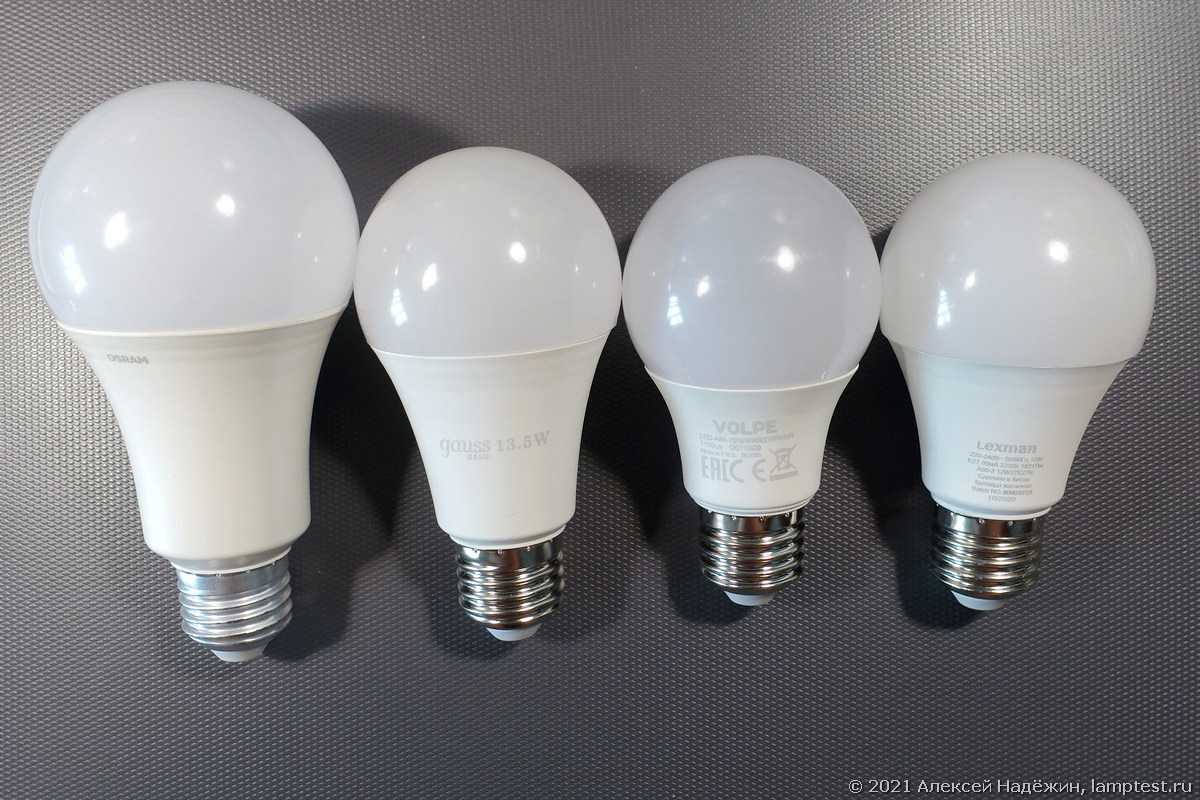
On the Leroy Merlin website there are many lamps that meet the parameters of "pear 12-15 W, warm light", but only these four were available in the store.
It's funny that the highest luminous flux (the highest brightness) is declared for the Lexman lamp with the smallest declared power of 12 W, while the OSRAM lamp with the highest declared power of 14 W has the lowest luminous flux of 1080 lm, while this lamp is the largest. size.

The most attentive will be surprised that the third lamp says "Volpe". This is a lamp "Norma", it's just that the Uniel company has spread so many brands that it itself gets confused in them. :) In addition to Uniel, Volpe and Norma, they also have the Yarkaya brand for lamps made in Russia and the KakSolntse brand for high CRI lamps.
Here are the results of my measurements.

The most expensive Gauss Basic lamp has a measured color rendering index of only 73, while it is declared 80. I note that almost all lamps of this brand have this: CRI> 90 is written on Gauss lamps in black boxes, but in fact there is a little higher than 80, on lamps in white boxes Gauss Basic (this is a special series for Leroy Merlin) and Gauss Elementary are written CRI> 80, but in fact, just above 70. And this lamp has the shortest warranty period - 1 year.
The Norma lamp "claims to be" powerful and bright, but in fact its power is less than 9 W (and not 13, as it is written on the box), and the measured luminous flux was only 767 lumens. This lamp can replace a 75-watt incandescent lamp, and not 120 watts, as the manufacturer promises. This lamp has the lowest efficiency at 86 lm / W. And it also cannot work correctly with a switch that has an indicator: it glows dimly when such a switch is turned off.
The OSRAM lamp is striking in its price - 82 rubles for an honest 14 W (this is very cheap). But there are nuances.
The measured luminous flux of this lamp was 1243 lm (15% higher than promised!), It has no ripple, CRI (Ra) 82 color rendering index, it works correctly with switches that have an indicator. This lamp has two drawbacks: the low efficiency of 89 lm / W and a linear driver, due to which the brightness of the lamp directly depends on the voltage in the network. There is 230 volts in the network, the lamp shines brightly and without pulsation. At 223 V, the brightness drops by 5%, and at 200 V, the brightness drops by almost half and a ripple appears.
The Lexman lamp (this is Leroy Merlin's own brand) showed the exact correspondence of the measured parameters to the declared ones: the power was only 0.5 W less than the indicated one, the luminous flux was 1% higher than the indicated one. The lamp has a record efficiency of 134 lm / W. There is no ripple, CRI (Ra) 82, the lamp works correctly with switches that have an indicator. Thanks to the IC driver, the lamp has a built-in stabilizer: its brightness does not change in the range of 170-250 V and it does not react to voltage surges in the network. The manufacturer claims the equivalent of a 100 W incandescent lamp, but in fact it shines like a 135 W incandescent lamp at a voltage of 220 V. The
manufacturer's warranty is 3 years and during this period you can exchange the lamp at any Leroy Merlin store (not necessarily where you bought ) if the lamp fails.
Before testing, the lamps were warmed up for at least 30 minutes. The measurements were carried out at a voltage of 230 V (the lamps were powered by a Shtil InStab 500 stabilizer). Color Temperature, Color Rendering Index and Ripple Coefficient were measured with an Uprtek MK350D. The luminous flux was measured using a half-meter integrating sphere and the same Uprtek MK350D spectrometer. Power consumption was measured with a Robiton PM2. The minimum voltage level at which the luminous flux of the lamp decreased by no more than 5% of the nominal was measured using a Lamptest-1 device and a LATR Suntek TDGC2-0.5.
The best of the four was the Lexman. I hope that in addition to the exact match of the parameters, this lamp will last a long time (the use of modern LEDs and a 3-year warranty give such hope). If your mains voltage never drops below 220 volts, an OSRAM lamp is also a good choice.
© 2021, Alexey Nadezhin